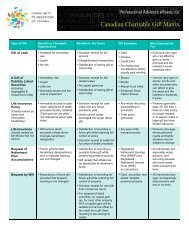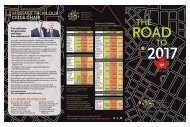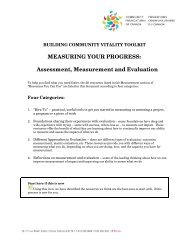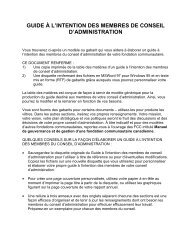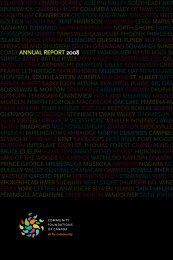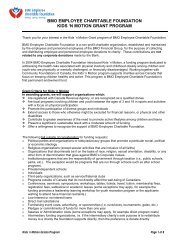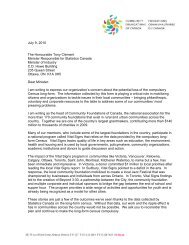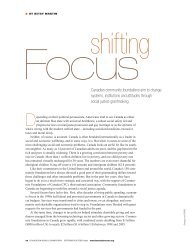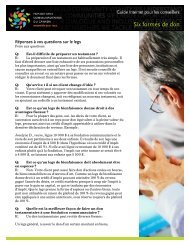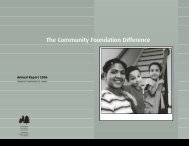Aboriginal Philanthropy in Canada: A Foundation for Understanding
Aboriginal Philanthropy in Canada: A Foundation for Understanding
Aboriginal Philanthropy in Canada: A Foundation for Understanding
You also want an ePaper? Increase the reach of your titles
YUMPU automatically turns print PDFs into web optimized ePapers that Google loves.
Priorities – Who Says?<br />
Closely related to the issue of worldviews is the issue<br />
of who sets priorities <strong>for</strong> fund<strong>in</strong>g, alluded to <strong>in</strong> the quote<br />
above.<br />
Indigenous priorities are many, varied and significant,<br />
cross<strong>in</strong>g all areas of exist<strong>in</strong>g philanthropic pursuits.<br />
Conventionally, most philanthropic organizations, <strong>in</strong>deed<br />
most Canadians, have tended to frame their concern<br />
<strong>for</strong> First Peoples <strong>in</strong> terms of “issues” or “challenges”<br />
such as substandard hous<strong>in</strong>g, poor water treatment,<br />
unequal education <strong>in</strong>vestment at all levels, vulnerability<br />
of language and culture, diabetes, proximity to extractive<br />
activities, access to capital, languish<strong>in</strong>g land claims and<br />
racism. Both the literature review and key <strong>in</strong><strong>for</strong>mant<br />
<strong>in</strong>terviews highlighted the need to move away from issue<br />
or challenge centred th<strong>in</strong>k<strong>in</strong>g to a more holistic vision.<br />
Respondents from foundations that have successful<br />
relationships with First Peoples or want to expand<br />
these relationship and from <strong>Aborig<strong>in</strong>al</strong> organizations<br />
emphasized the importance of self-determ<strong>in</strong>ation as<br />
a cornerstone of success. Many respondents stated<br />
emphatically that the priorities needed to be identified by<br />
First Nations, Inuit and Métis peoples themselves. One<br />
respondent stated “I’m not go<strong>in</strong>g to guess that, I mean<br />
I don’t know that; I’m not <strong>Aborig<strong>in</strong>al</strong>. <strong>Aborig<strong>in</strong>al</strong> people<br />
can tell us what their needs are.” Self-determ<strong>in</strong>ation<br />
has been a value of First Nations <strong>in</strong> <strong>Canada</strong> throughout<br />
their history and rema<strong>in</strong>s central to the structure of<br />
successful relationships between First Peoples and all<br />
sectors of Canadian society. As one respondent stated:<br />
“First Nations need to be a player and shape their own<br />
development, <strong>in</strong>clud<strong>in</strong>g the development of lands and<br />
resources.”<br />
While those <strong>in</strong>terviewed did not presume to speak<br />
on behalf of First Peoples, they were articulate about<br />
what they perceived to be some of the priority areas<br />
<strong>for</strong> fund<strong>in</strong>g <strong>in</strong> <strong>Aborig<strong>in</strong>al</strong> communities. Economic<br />
development was cited most often as a priority area;<br />
one respondent described the range of issues related to<br />
economic development as follows:<br />
“What I hear is that the emphasis is on economic<br />
self-sufficiency and revenue generators and a means<br />
to address the second tier issues of <strong>in</strong>dependent<br />
governance; the ability to steward lands and resources<br />
and participate on equal foot<strong>in</strong>g; social programs<br />
and economic activity and the specifics of social<br />
programm<strong>in</strong>g. Primarily, economic development as a<br />
means to job creation, to help with the social programs.”<br />
Infrastructure also was mentioned a number of<br />
times, particularly as it related to the economy. One<br />
respondent stated:<br />
“The economic and build<strong>in</strong>g <strong>in</strong>frastructure <strong>in</strong> most<br />
<strong>Aborig<strong>in</strong>al</strong> communities is so poor, so far beh<strong>in</strong>d<br />
that it impacts everyth<strong>in</strong>g. There are very, very few<br />
organizations and foundations that I’m aware of that<br />
support anyth<strong>in</strong>g to do with <strong>in</strong>frastructure. Without that<br />
k<strong>in</strong>d of <strong>in</strong>frastructure it’s difficult to function as a healthy<br />
community. Local communities <strong>in</strong> middle Manitoba<br />
have a curl<strong>in</strong>g r<strong>in</strong>k, a skat<strong>in</strong>g r<strong>in</strong>k, and offer hockey,<br />
r<strong>in</strong>gette, anyth<strong>in</strong>g to do with w<strong>in</strong>ter activities. Similar size<br />
communities <strong>in</strong> First Nations areas have noth<strong>in</strong>g and that<br />
impacts their ability to do th<strong>in</strong>gs that their neighbours<br />
do.”<br />
Education is another priority area that was identified<br />
by several respondents. One respondent elaborated:<br />
“Education is high on the list, and the landscape<br />
aga<strong>in</strong>st which it plays out. The Assembly of First Nations<br />
(AFN) study also po<strong>in</strong>ts out that it is not just scholarship,<br />
but that <strong>Aborig<strong>in</strong>al</strong> youth need support – peers and<br />
mentorship. We need to provide youth with support <strong>in</strong><br />
terms of family – that’s where they get their support.<br />
Other areas are poverty and all that’s <strong>in</strong>volved with that,<br />
bully<strong>in</strong>g. The AFN’s <strong>in</strong>terest <strong>in</strong> post-secondary education<br />
and role models, quality of life comparative to everyone<br />
else.“<br />
The Circle on <strong>Philanthropy</strong> & <strong>Aborig<strong>in</strong>al</strong> Peoples <strong>in</strong> <strong>Canada</strong> 24



